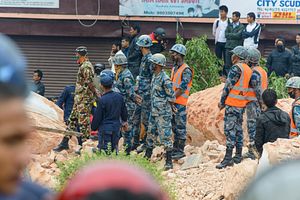Nepal has this week requested that foreign search-and-rescue teams leave the country, less than 10 days after a 7.8-magnitude earthquake devastated the Himalayan nation. Officially, the government has said that it can complete the remaining tasks on its own, although the available evidence suggests otherwise.
I spoke with Laxmi Prasad Dhakal, joint secretary and spokesperson of the Ministry of Home Affairs, who told me that the government is “thankful” to the 34 countries that sent 76 search-and-rescue teams, comprising 4,060 people, for doing a “good job.”
However, he insisted that Nepal had the capacity to finish the remaining work, and citied guidelines of the International Search and Rescue Advisory Group, or INSARAG, which says seven days are enough for the task.
I asked him what percentage of the debris had been removed, given that clearing rubble is a key part of search and rescue operations.
Dhakal didn’t have any figures to quote about the removal of the debris, but said it was now unlikely that more survivors would be found. Given the government’s preoccupation with the gigantic task of providing relief material to survivors and homeless people, the lack of information is hardly surprising. But Dhakal pointed out that 40 percent of the debris had been cleared from the seven UNESCO World Heritage sites in Kathmandu Valley.
I then spoke to Nepalese journalists and friends about their government’s decision to send the foreign rescue teams away. Surprisingly, none were unhappy about it.
“I think this was done partly on the assessment of the government of Nepal as well as that of some external rescue teams that no useful purpose would be served any more by keeping a huge number of external rescue teams,” said senior journalist Yubaraj Ghimire. “The Nepalese security forces, which have done a wonderful job despite the resource crunch, can handle any remaining search and rescue operations.”
Rabi Raj Baral, a correspondent with PahiloPost, seconded Yubaraj: “According to government officials, search and rescue teams have the obligation to rescue people alive, and they get seven days. The time has passed, and there is no possibility of rescuing people alive.”
Still, Nepal had nothing to lose keeping the foreign rescuers in country. They could have been used to clear debris and retrieve bodies even as they looked for more survivors. Besides, removing debris is the first step in the rebuilding process.
Dhakal told other news outlets that 200,552 houses have been destroyed and another 186,285 houses were damaged, according to preliminary data. The actual number is likely to be much higher. My own admittedly rough estimate based on what I witnessed during my recent visit to Nepal, less than 10 percent of the debris from the destroyed houses has been removed, and the stench emanating from many sites where rubble has yet to be cleared suggests that bodies remain beneath the debris.
Landslides caused by the April 25 earthquake and aftershocks have also scattered debris on roads with the bodies of commuters still buried beneath, adding to the work of local personnel.
Meanwhile, Nepal’s health ministry has said it will allow only a few teams of health workers in the country, and others will be asked to return home.
One possible reason why the Nepal government has been reluctant to continue to host foreign teams could be that the two largest rescue teams were from Nepal’s two giant neighbors India and China, who are competing for influence in the Himalayan nation – reportedly even at the time of this unspeakable tragedy in Nepal.
The earthquake struck Nepal at a time when its political parties were fighting over the provisions of an overdue new constitution to cement the country’s transition from Hindu monarchy to secular democracy. Sovereignty and geopolitics were part of the national debate.
Nepal has been especially wary of India’s alleged “big brother” attitude, and the Indian media, especially news channels, haven’t helped. New Delhi’s prompt response to the earthquake was initially lauded by the Nepalese people, but only until sections of the Indian media overshadowed it with their insensitive reporting and public relations-like boasting.
Coverage of Nepal by Indian media is obviously meant for Indian consumption, apparently to boost the Bharatiya Janata Party-led government’s image at home, but most Nepalese people, too, have access to Indian news channels. More than 128,000 tweets have discussed – often critically – the handling of Nepal’s earthquake by the Indian press, according to Hindustan Times. Hashtags #GoHomeIndianMedia and #DontComebackIndianMedia are trending on Twitter.
There are also concerns related to the Western presence in Nepal, especially among supporters of right-wing Hindu parties and the bureaucracy, which is dominated by so-called high-caste Hindus. They see Western nations as having a “conversion” agenda in Nepal, a notion which some self-proclaimed Christian preachers in the United States have perpetuated with their statements, eclipsing the good work that local and international Christian groups are doing in Nepal.
The subtext of Nepal’s refusal to seek much on-the-ground help from foreign nations is loud and clear: Nepal may not be able to deal with the aftermath of the earthquake on its own, but it cannot accept assistance at the cost of the nation’s sense of sovereignty and self-respect. And Nepal’s media and most Nepalese people seem to be with their government on this.

































